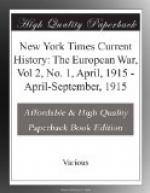Germany raises (average for 1912-13) about 4,500,000 tons of wheat and imports nearly 2,000,000 tons, (about 73,000,000 bushels.) On the other hand, it exports about 530,000 tons net of the 11,900,000 tons of rye produced. It imports nearly 3,000,000 tons of low-grade barley and about 1,000,000 of maize, both chiefly for feeding stock. Its net imports of grain and legumes are 6,270,000 tons. Of its fruit consumption, about 30 per cent. has been imported. While Germany has been producing nearly its entire meat supply at home, this has been accomplished only by the very extensive use of foreign feedstuffs. The authors of this work estimate that the imports of meats and animals, together with the product from domestic animals fed with foreign feedstuffs, amount to not less than 33 per cent. of the total consumption. They also hold that about 58 per cent. of the milk consumed in Germany represents imports and the product of cows fed with foreign feedstuffs. Nearly 40 per cent. of the egg consumption was hitherto imported. The consumption of fish has averaged 576,000 tons, of which not less than 62 per cent. was imported; and the home fisheries are now confined, besides the internal waters, almost wholly to the Baltic Sea—which means the loss of the catch of 142,000 tons hitherto taken from the North Sea. Even the German’s favorite beverage, beer, contains 13 per cent. of imported ingredients.
The authors assume, as already intimated, that nearly all of these imports will be lost to Germany during the full duration of the war, and they take up, under this big limitation, the problem of showing how Germany can live upon its own resources and go on fighting till it wins. They undertake to show how savings can be made in the use of the supplies on hand, and also how production can be increased or changed so as to keep the country supplied with food products.
In the first place, they insist that the prohibition of the export of grain be made absolute; in other words, the small exception made in favor of Switzerland, which has usually obtained most of its grain from Germany, must be canceled. Savings in the present supplies of grain and feedstuffs must be made by a considerable reduction in the live stock, inasmuch as the grain, potatoes, turnips, and other stuffs fed to animals will support a great many more men if consumed directly by them. From the stock of cattle the poorer milkers must be eliminated and converted into beef, 10 per cent. of the milch cows to be thus disposed, of. Then swine, in particular, must be slaughtered down to 65 per cent. of the present number, they being great consumers of material suitable for human food. In Germany much skim milk and buttermilk is fed to swine; the authors demand that this partial waste of very valuable albumens be stopped. The potato crop—of which Germany produces above 50,000,000 tons a year, or much more than any other land—must be more extensively drawn upon than hitherto for feeding




